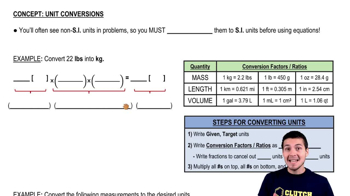Here are the essential concepts you must grasp in order to answer the question correctly.
pV Diagram
A pV diagram, or pressure-volume diagram, is a graphical representation of the relationship between the pressure (p) and volume (V) of a gas during a thermodynamic process. It helps visualize how the state of a gas changes under various conditions, such as isothermal or adiabatic processes. The area under the curve in a pV diagram represents the work done by or on the gas.
Recommended video:
Ideal Gas Law
The Ideal Gas Law is a fundamental equation in thermodynamics that relates the pressure, volume, temperature, and number of moles of an ideal gas. It is expressed as PV = nRT, where P is pressure, V is volume, n is the number of moles, R is the ideal gas constant, and T is temperature in Kelvin. This law provides a basis for understanding the behavior of gases under various conditions.
Recommended video:
Ideal Gases and the Ideal Gas Law
Temperature Conversion
Temperature conversion is the process of changing a temperature value from one scale to another, such as from Celsius to Kelvin. The Kelvin scale is an absolute temperature scale where 0 K is absolute zero, and it is used in scientific calculations. The conversion from Celsius to Kelvin is done by adding 273.15 to the Celsius temperature, which is crucial for accurately applying the Ideal Gas Law and other thermodynamic equations.
Recommended video:
 Verified step by step guidance
Verified step by step guidance


